Items filtered by date: July 2024
Types of Toe Walking in Children
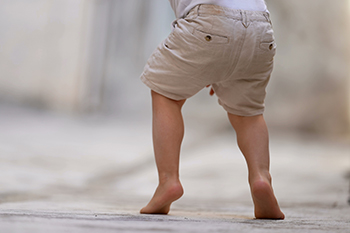
Toe walking is common among toddlers learning to walk, but if it persists beyond the age of two, it may be a sign of underlying issues. Classifications of toe walking in children include neurological, orthopedic, developmental, and idiopathic. Neurological toe walking may involve conditions like cerebral palsy or muscular dystrophy, which lead to muscle tightness or weakness. Orthopedic issues, such as clubfoot or inflammatory diseases, can cause pain that leads children to avoid placing their heels on the ground. Developmental delays and cognitive disorders, including autism spectrum disorders, can also contribute to toe walking. This may be caused by sensory processing challenges. Idiopathic toe walking, seen in healthy children without apparent medical problems, might be linked to tight calf muscles or a family history of toe walking. A chiropodist can help identify the specific cause of toe walking to help a parent make an appropriate health care decision for their child. If your child consistently walks on the toes, it is suggested that you schedule an appointment with a chiropodist for an exam, diagnosis, and possible treatment options.
If your child is experiencing foot or ankle pain, please consult with Cynthia Chan, B.Sc., D.Ch from Healthy Advantage Foot & Orthotic Clinic. Our practitioner will assess your condition and provide you with quality foot and ankle treatment.
Common Causes of Foot Pain in Children
While children can experience many of the same foot problems as adults do, some foot problems may be more common during childhood.
Causes of foot pain in children can include:
Deformities that are present from birth, such as flat feet or clubfoot
Sever’s disease, which is an inflammation of the growth plate in the heel bone
Various sports injuries, such as sprains and fractures
Ingrown toenails
Athlete’s foot
Plantar warts
Prevention
It is important to look after the health of children’s feet in order to prevent future problems from arising. Keep your child’s feet clean and dry, trim their toenails regularly, ensure their shoes fit properly, and keep a watchful eye on any symptoms of foot pain, such as limping. If you notice any symptoms or if your child complains of foot pain, a chiropodist can help.
If you have any questions, please feel free to contact our office located in . We offer the newest diagnostic and treatment technologies for all your foot care needs.
Treatment Options for Ingrown Toenails
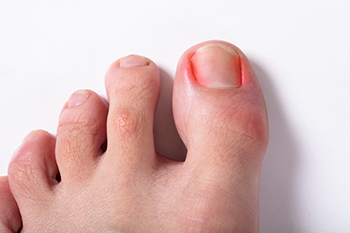 Ingrown toenails can be painful and bothersome, but many non-surgical treatments are available to alleviate symptoms. At the first sign of pain, soaking the affected toe in warm soapy water for up to 20 minutes can soften the skin, allowing you to push it back from the nail edge. Applying antiseptic or anti-inflammatory creams may prevent infection and soothe the skin. A chiropodist can assist with more advanced non-surgical methods, such as using small pieces of sterile cotton to lift the nail away from the skin and securing it with a gauze bandage. Special tools like toenail braces or plastic gutter splints, applied by a chiropodist, can help to keep the nail from pressing into the skin and allow it to grow normally. These treatments typically require patience, as it may take several months for the nail to grow out of the inflamed area. If you have severe pain or notice pus or persistent inflammation, it is advisable to consult a chiropodist immediately. For help in managing an ingrown toenail, it is suggested that you schedule an appointment with a chiropodist for an exam, diagnosis, and treatment.
Ingrown toenails can be painful and bothersome, but many non-surgical treatments are available to alleviate symptoms. At the first sign of pain, soaking the affected toe in warm soapy water for up to 20 minutes can soften the skin, allowing you to push it back from the nail edge. Applying antiseptic or anti-inflammatory creams may prevent infection and soothe the skin. A chiropodist can assist with more advanced non-surgical methods, such as using small pieces of sterile cotton to lift the nail away from the skin and securing it with a gauze bandage. Special tools like toenail braces or plastic gutter splints, applied by a chiropodist, can help to keep the nail from pressing into the skin and allow it to grow normally. These treatments typically require patience, as it may take several months for the nail to grow out of the inflamed area. If you have severe pain or notice pus or persistent inflammation, it is advisable to consult a chiropodist immediately. For help in managing an ingrown toenail, it is suggested that you schedule an appointment with a chiropodist for an exam, diagnosis, and treatment.
Ingrown toenails may require medical attention. If you have significant pain or notice signs of infection from an ingrown toenail, please consult with Cynthia Chan, B.Sc., D.Ch from Healthy Advantage Foot & Orthotic Clinic. Our practitioner will assess your condition and provide you with quality foot and ankle treatment.
What Is an Ingrown Toenail?
An ingrown toenail occurs when the edges of a toenail grow into the surrounding skin. The toenails of the big toe are usually affected, however, an ingrown toenail can happen on any toe. Sometimes, the area can become infected leading to potentially serious complications. The ingrown toenail may be caused by improper trimming of the toenail, wearing ill-fitting shoes, or injury to the nail.
Symptoms
The symptoms of an ingrown toenail include:
Pain
Swelling
Redness
Warmth
Pus or drainage from the affected nail or a fever may indicate an infection of the area.
Treatment
Treatment depends on the severity of the ingrown toenail. In less severe cases, home treatment may be adequate. Soaking the affected foot in warm water and gently lifting the nail from the skin with a piece of clean cotton can help. In more severe cases, you may need to use topical or oral antibiotics to treat an infection. Surgical removal of the ingrown toenail may be required if more conservative treatments fail.
Ingrown toenails may be prevented by wearing well-fitted shoes and properly trimming the toenails. Toenails should be trimmed straight across and not too short when using nail clippers.
If you have any questions, please feel free to contact our office located in . We offer the newest diagnostic and treatment technologies for all your foot care needs.
Causes and Risk Factors of Toenail Fungus
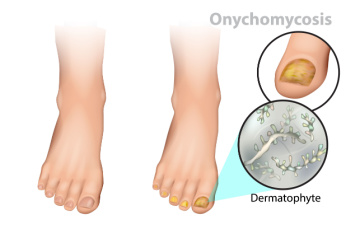
Toenail fungus is caused by the overgrowth of fungi such as dermatophytes and yeast in the toenail. These fungi can be airborne or naturally present on the skin, finding their way to the foot or toenail. They thrive in warm, humid environments, so damp or sweaty feet create ideal conditions for fungal proliferation. Any cracks or tears in the skin or nail can serve as entry points, allowing the fungi to penetrate deeper tissues. Once inside, they feed on the nail tissue, causing the nail to thicken, discolor, and detach from the nail bed as fungal debris accumulates. Common symptoms of toenail fungus include thickened, yellow, brown, or white nails that may develop cracks over time. While the infection often starts without pain, it can become progressively severe. Risk factors for toenail fungus include old age, previous nail trauma, and wearing tight footwear. Engaging in activities like running or swimming, and having conditions such as diabetes, blood circulation problems, are possible causes. If left untreated, toenail fungus can spread to surrounding skin, other nails, and even other parts of the body If you have developed a toenail infection, it is suggested that you schedule an appointment with a chiropodist for an exam, diagnosis, and treatment options.
Toenail fungus can be uncomfortable and unsightly. If you have diabetes or a compromised immune system, it may also be dangerous. To learn more about treatment options, please consult with Cynthia Chan, B.Sc., D.Ch from Healthy Advantage Foot & Orthotic Clinic. Our practitioner will assess your condition and provide you with quality foot and ankle treatment.
What Does Toenail Fungus Look Like?
A fungal infection of the toenail may cause the affected nail to become thickened, brittle, crumbly, and yellowish or brown in color. Sometimes the toenail may separate from the nail bed, become deformed, emit a foul odor, or cause pain or discomfort.
What Causes Toenail Fungus?
Toenail fungus is caused by a fungus that infects the nail bed. The fungus lives and thrives in warm and moist environments and is also contagious. Athlete’s foot, which is a fungal infection of the skin, may spread to the nails and cause toenail fungus.
What Treatments Are Available?
Potential treatments for toenail fungus may include oral antifungal medications, topical antifungal medications, such as medicated nail polishes that are applied directly to the affected nail, and laser therapy. Sometimes, a combination of treatments is prescribed.
If you have any questions, please feel free to contact our office located in . We offer the newest diagnostic and treatment technologies for all your foot care needs.
Ankle Injuries From Football
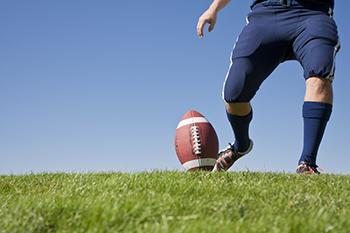 Football players are prone to various ankle injuries due to the sport's high impact and rapid directional changes. Common ankle injuries include sprains, fractures, and Achilles tendonitis. Ankle sprains occur when the ligaments are overstretched or torn, typically from sudden twists or impacts. Fractures result from direct blows or severe twists, leading to broken bones. Achilles tendonitis is the inflammation of the Achilles tendon, often from overuse or repetitive stress. These injuries happen due to the intense physical demands of football, including running, jumping, and tackling. Poor playing surfaces, inadequate warm-ups, and wearing improper footwear can increase the risk. Immediate treatment involves rest, elevation, and compression. Pain relievers and anti-inflammatory medications can help manage pain and swelling. Severe injuries may require immobilization, targeted stretching exercises, or perhaps surgery. Preventing ankle injuries includes proper conditioning, wearing supportive footwear, and performing exercises that strengthen the ankle muscles and improve flexibility. If you believe you have injured your ankle while playing football, it is suggested that you schedule an appointment with a chiropodist for specialized care to ensure a safe return to the field and prevent future injuries.
Football players are prone to various ankle injuries due to the sport's high impact and rapid directional changes. Common ankle injuries include sprains, fractures, and Achilles tendonitis. Ankle sprains occur when the ligaments are overstretched or torn, typically from sudden twists or impacts. Fractures result from direct blows or severe twists, leading to broken bones. Achilles tendonitis is the inflammation of the Achilles tendon, often from overuse or repetitive stress. These injuries happen due to the intense physical demands of football, including running, jumping, and tackling. Poor playing surfaces, inadequate warm-ups, and wearing improper footwear can increase the risk. Immediate treatment involves rest, elevation, and compression. Pain relievers and anti-inflammatory medications can help manage pain and swelling. Severe injuries may require immobilization, targeted stretching exercises, or perhaps surgery. Preventing ankle injuries includes proper conditioning, wearing supportive footwear, and performing exercises that strengthen the ankle muscles and improve flexibility. If you believe you have injured your ankle while playing football, it is suggested that you schedule an appointment with a chiropodist for specialized care to ensure a safe return to the field and prevent future injuries.
Injuries to the foot and ankle are very common among athletes. If you have experienced an injury, please consult with Cynthia Chan, B.Sc., D.Ch from Healthy Advantage Foot & Orthotic Clinic. Our practitioner will assess your condition and provide you with quality foot and ankle treatment.
Common Injuries Among Athletes:
Achilles tendon injuries
Ankle strains or sprains
Plantar fasciitis
Fractures
Turf toe
Joint dislocations
Sever’s disease
Morton’s neuroma
Symptoms
Symptoms will depend on the cause and severity of the injury. Common symptoms for a foot or ankle injury include pain, swelling, tenderness, bruising, a reduced range of motion, and difficulty bearing weight or walking on the affected foot or ankle.
Diagnosis
Sports injuries are typically diagnosed after carefully examining the affected foot or ankle. This includes moving the injured area to test its range of motion. Medical history will need to be provided, as well as detailed information about how the injury occurred. Imaging studies, such as X-rays or MRIs, may be used to confirm or rule out certain diagnoses.
Treatment
Just like symptoms, treatment will depend on the type of injury and its severity. Initial treatment for many sports injuries is aimed at controlling inflammation and promoting the healing response. The acronym R.I.C.E is a helpful guide to implement for most acute injuries. This method involves resting, icing, compressing, and elevating the affected foot or ankle. In addition, anti-inflammatory medications may be administered and orthotic devices may be prescribed. For more severe injuries, surgery may be required. Lastly, rehabilitation or physical therapy may be needed to gain full functionality in the afflicted area.
If you have any questions, please feel free to contact our office located in . We offer the newest diagnostic and treatment technologies for all your foot care needs.
Causes and Types of Corns
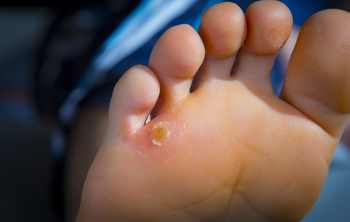
Corns are thickened areas of skin that develop due to repeated friction or pressure, typically on the feet. They often form from wearing ill-fitting shoes that rub against the skin, prolonged walking or standing, and foot deformities like hammertoes or bunions. Corns come in two main types, known as hard and soft. Hard corns are small, dense patches that usually develop on the tops or sides of toes. Soft corns are found between toes and have a rubbery texture due to moisture. Both types can cause discomfort and pain when walking or wearing shoes. Addressing the root cause, such as changing footwear, using protective pads, and keeping feet dry, is essential for preventing and managing corns effectively. Many people experience pain and discomfort with corns. If this applies to you, it is suggested that you consult a chiropodist who can effectively treat corns and offer you prevention tips.
Corns are small bumps or dry, hardened skin that can arise on the feet, usually in response to friction. Corns can be asymptomatic, or they can be uncomfortable or painful. If you have corns that are bothering you, please consult with Cynthia Chan, B.Sc., D.Ch from Healthy Advantage Foot & Orthotic Clinic. Our practitioner can help you maintain the health of your lower limbs and your mobility.
There are three types of corns:
Hard corns
Often occur on the tops of toes
Feature a hard core surrounded by dry, irritated skin
Can be painful
Soft corns
Often occur in between the toes
Soft due to constant exposure to sweat
Can be painful
Seed corns
Tiny
Often occur on the soles of the feet
Usually asymptomatic
Corns can be prevented by wearing shoes that fit properly. They are typically benign and don’t require medical treatment. However, if your corns are causing you pain or discomfort, don’t hesitate to reach out to a chiropodist near you for treatment options. If you have any questions, please feel free to contact our office located in . We offer the newest diagnostic and treatment technologies for all your foot care needs.